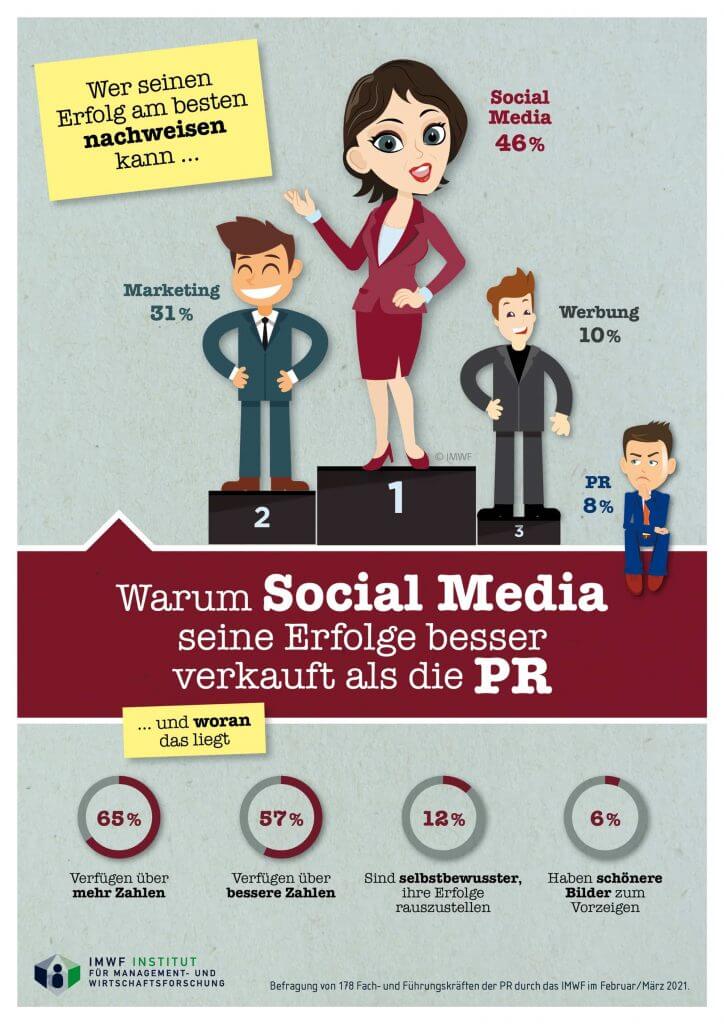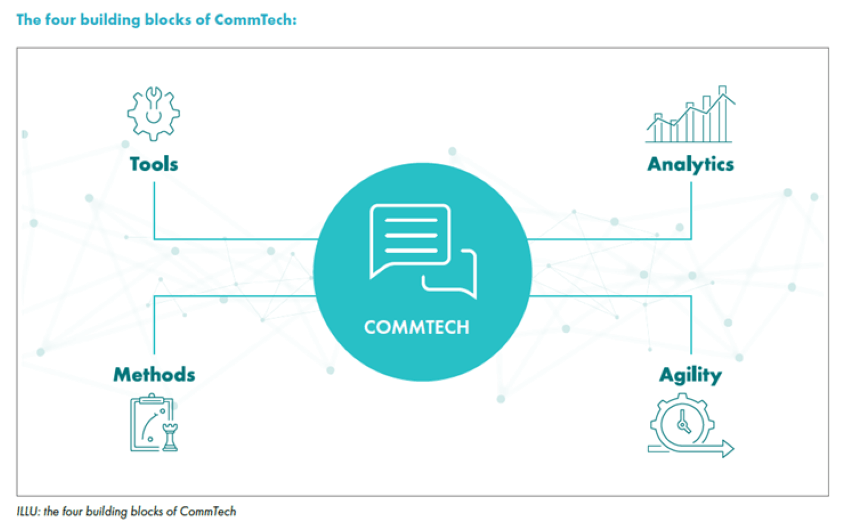- 1. February 2022
- Posted by: Die Redaktion
- Category: NEWS

Data makes the difference in PR

Author: Thomas Mickeleit
Let’s face it, what communicator hasn’t suffered from the subtle pushbacks we encounter in everyday corporate life. The presentation of an important communications strategy is dropped from the board’s agenda because of other “priorities,” the briefing time for an interview is cut to ten minutes, or warnings about action or inaction and its communicative consequences are thrown to the wind.
As a rule, these disregards are not directed against the person, but it is the “communication” function that is not seen on a par with finance, human resources and marketing (not to mention production and sales). This finding is supported by surveys that can already be read in the “European Communications Monitor 2019”.
While 93 percent of communicators think they enjoy the personal trust of their top executives, only 67 percent believe the same is true of their role1. A very recent study by the IMWF2 is even clearer. When asked which function the organization’s top management listens to above all when it comes to strategic issues, Finance / Controlling is far ahead at 63 percent. At 36 percent, communication comes in a distant second.
More important than the findings is the question of why this is so – and there are indications there, too. If comms professionals want to be seen as key players in their organization, they need to use the language of management and report successes accordingly3. This brings us to the core of the “problem”. While in finance the sales forecast often leads to amazingly exact results with the help of artificial intelligence, in sales the work would be almost impossible without the evaluations from the customer relationship management system (CRM) and the customer journey in marketing is accompanied under the keyword “automated marketing”, technology and data in communication have so far only played a subordinate role.
It may have something to do with the fact that the profession magically attracts all those who have not found fulfillment in math and physics. That’s why all the “technology clutter” that colleagues from other corporate functions use to increase the probative value of their statements tends to be viewed with suspicion or even rejected. There are also other reasons and if it is the tight budget. The bottom line is that this has fatal consequences.
We must learn to work in a data-driven way
As communicators, we are in a race to catch up with other business functions. On the surface, this scratches at the reputation. Already, if we are to gain acceptance as a “trusted advisor” to management, we must learn to be data-driven and learn from other business functions. But if we are permanently left behind, it is not just a question of standing in the organization, but of whether communication can still deliver its value-added contribution at all in a data-driven environment.
What we can learn from marketing
Marketing has undergone a sweeping transformation in recent years. With the invention of content marketing and the advent of social media, marketing and communications are operating in the same waters, but with different goals – and different levels of success. Let’s acknowledge that marketing has mastered a highly effective methodology with the Customer Journey and the “Funnel” leading to closure, also known as “Automated Marketing”. This in turn is driven by MarTech, which is the end-to-end data-driven mapping of all customer touch points along this journey. We can only dream of that in communications at the moment. The success factor here, as everywhere, is data. Who is likely to be interested in which product or service and when, and how do I reach this person? Figuratively speaking, this replaces the blind-fired shot with the shotgun with an aimed shot from the hunting rifle.
Content is king – but not if no one knows it
We must not make ourselves artificially small, but the truth is also that communicators put the lion’s share of work into creating the content and already react bored when asked about the best possible distribution. This was already the case when it came to sending out press releases, where the “one-size-fits-all distribution list” was used without any further checks, and it continues in blind actionism when it comes to operating social media channels. The main thing is to get out – in recognition of the fact that then the work only begins. What if communication succeeded in describing a stakeholder journey analogous to the customer journey, at the end of which there was no purchase but the generation of a “fan”.
That this idea is not utopian, even if it is in its infancy, is something we are learning from the already more advanced debate in the USA. The term CommTech – in reference to MarTech – is attracting increasing attention and most recently became more widely accessible through the “Arthur Page Society“4. She even talks about CommTech as a new profession.

At its core, this is about enabling companies to address stakeholders as individuals rather than as a blanket target group, using data-driven precision that covers four core areas (see Fig. 1)5: Tools, Analytics, Methods, and Agility.
It is beyond the scope of this paper to present in the required breadth where the idea of CommTech can help us build holistic, data-driven end-to-end communications. However, we will need them to track for our profession what marketing has already largely implemented.
What we can no longer wait for is to use data that is basically available to us and thus be able to make fact-based arguments in reporting and, more importantly, in strategic consulting. This is still quite obviously lacking. According to the self-assessment of communicators as to why other corporate functions always succeed better in presenting themselves as successful in corporate management, 54 percent of respondents in the already cited IMWF study of March 2021 think “there is a lack of hard numbers” and identify this circumstance as the most important hurdle to bringing communication to eye level.
“Hard numbers” are “relevant numbers”
This quickly becomes clear when you look a little closer. Take media evaluations, for example: After all, only a few communicators still measure their success on a monthly basis by the amount of clipping stack printed. However, it is also true that a not inconsiderable part of PR budgets goes into the creation of clipping reports that, on balance, serve no better purpose, namely reporting purposes. In practice, people often look at what is happening with a considerable distance. Measuring success is a very, very downstream matter, and the greater the distance between a media event and the measurement of success, the less “relevant” the result. What insights can communications management or even senior management draw from aggregated four-week-old data, other than perhaps feeling good about the effort and outcome of an activity?
More and more communicators feel the discomfort of missing something. Only 67 percent of communications executives surveyed by IMWF have information about the number of publications the day after a media event. Only slightly more than half (54%) know the distribution across the different media channels the next day, and only slightly more than a third (35%) know the tone of the posts after one day6. For the vast majority of communicators, this means nothing other than communicating in a permanent blind flight. In fact, it is as if the navigation system in the car always shows you a point one kilometer back as your own location. How are you supposed to catch the right descent? How can you ever reach the goal like that?
It is therefore not surprising that, under the given circumstances, media evaluations can “only” be used for reporting, which is only useful for controlling communication at the meta-level and in long cycles. We are thus a long way from a strategic approach to communications management, not to mention CommTech and end-to-end stakeholder management.
What communications managers need is “real-time data.”
Only data in quasi real time enables the step from retrospective reporting to forward-looking control of communication – operationally and strategically. In practical terms: Only the immediate availability of comprehensive evaluations of tonality down to the level of individual players in the opinion market, allows interactions, readjustment of messages, positioning of “third-party-voices”, effective orchestration of owned, earned and paid across all channels. This approach increases the effectiveness of an ongoing activity or provides the opportunity to intervene early in the event of an emerging issue.
It becomes strategic when immediate conclusions and course-setting for further communication measures are drawn from the data obtained. For example, when I recognize that the cast of a theme is particularly successful when it is played in the context of a particular other, or how my perception of a theme changes in relation to the competition. In the CommTech context, this would mean systematically recording the potential “fan base” and addressing them further – all in compliance with DSGVO, of course.
I do not expect any opposition to the proposal to proceed in this way. Expected is the objection, how is that supposed to work and who is supposed to pay for it? The good news is, Big Data and the use of artificial intelligence are working in place for us. The considerable time delays in the delivery of media evaluations are due to the fact that in the vast majority of cases they are carried out exclusively by humans. An international evaluation of a topic thus quickly becomes a major project involving hundreds of evaluators – with a corresponding price ticket. This explains why only a fraction of companies have the control-relevant data available within hours, and why these are naturally among the DAX ranks or similarly potent.
Democratize algorithms
One may be pleased to know, however, that there has since been progress in the development of algorithms that allow machine evaluation in a fraction of the time and cost. As already known from other contexts, cloud services enable access even for smaller companies and thus “democratize” these services in an almost revolutionary way. Admittedly, the market, although manageable in terms of the number of players, is quite opaque. In particular, there are significant gaps between promises of what is possible to what is delivered, as I can confirm from my own experience. For communications managers, this means taking the most obvious step and generating analytics data in a timely manner. The effort probably increases (depending on the scope of the evaluations), but what definitely increases is – to cut a long story short – the ability to bring relevant data into the organization that can be the basis for decision-making at the operational and strategic level.
The starting point of the media analysis, supplemented by broad-based social listening, was not chosen at random. With little effort, it can be expanded to become an effective staple of real-time sensing – and help organizations take a good step forward on the road to CommTech.
1) Zerfass, A., Vercic, D., Verhoeven, P., Moreno, A. & Tench, R. (2019). European Communications Monitor 2019. Exploring trust in the profession, transparency, artificial intelligence and new content strategies. Results of a survey in 46 countries. Brussels: EUPRERA/EACD, Quadriga Media Berlin. ECM2019-Results-ChartVersion (communicationmonitor.eu)
2) IMWF, Survey of professionals and managers in PR, March 2021 (not published).
3) Volk, S. C., Berger, K., Zerfass, A., Bisswanger, L., Fetzer, M., Köhler, K. (2017). How to play the game.
Strategic tools for managing corporate communications and creating value for your organization, p. 17 (Communication Insights, Issue 3). Leipzig, Germany: Academic Society for Management & Communication. Available online at
Academic Society
.
4) Home – CommTech Guide (page.org)
5) Fig. 1. The four Building Blocks of CommTech, Arthur Page Society, CommTech Guide, p. 17 (2020).
6) IMWF survey of PR professionals and managers, March 2021 (not published).
About the author: Thomas Mickeleit was Communications Director and Member of the Executive Board for Microsoft Germany until 2020. With the early use of data-based communication and the establishment of a newsroom model, the fully qualified lawyer set new standards there. Previously, Mickeleit successfully served as Head of Corporate Communications at Volkswagen AG and as Director of Communications at IBM Germany. Today, he works as a communications consultant for digital communications and is a member of the scientific advisory board of the Institute for Management and Economic Research (IMWF), Hamburg.
On the topic of the added value of data in PR, the
IMWF is organizing a webinar, which will be announced here
. One of the experts who will have his say is Thomas Mickeleit.

